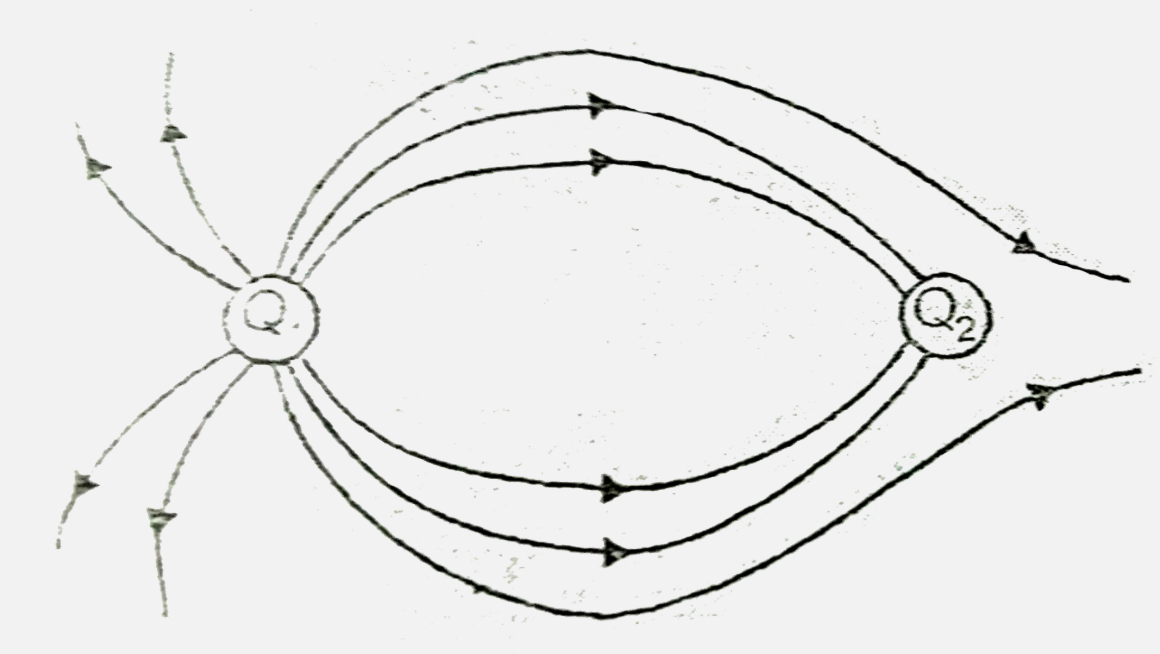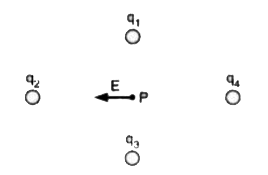What is the ratio of the charges ∣∣∣q1q2∣∣∣ for the following electric field line pattern ?
 Solution in Tamil
Solution in Tamil
a) 15
b) 2511
c) 5
d) 1425
The correct Answer is:A, B
Step by step video, text & image solution for What is the ratio of the charges |(q_(1))/(q_(2))| for the following electric field line pattern ? by Physics experts to help you in doubts & scoring excellent marks in Class 12 exams.
Topper's Solved these Questions
- BOOK - FULL MARKSCHAPTER - ELECTROSTATICS EXERCISE - Textual Evaluation Solved (II. Short Answer Questions : )21videos
ELECTROSTATICS
- BOOK - FULL MARKSCHAPTER - ELECTROSTATICS EXERCISE - Textual Evaluation Solved ( III. Long Answer Questions: )23videos
ELECTROSTATICS
- BOOK - FULL MARKSCHAPTER - ELECTROSTATICS EXERCISE - ADDITIONAL QUESTIONS SOLVED ( VII. NUMERICAL PROBLEMS )5videos
ELECTROSTATICS
- BOOK - FULL MARKSCHAPTER - DUAL NATURE OF RADIATION AND MATTEREXERCISE - ADDITIONAL QUESTIONS -( ADDITIONAL NUMERICAL PROBLEMS : )10videos
DUAL NATURE OF RADIATION AND MATTER
- BOOK - FULL MARKSCHAPTER - MAGNETISM AND MAGNETIC EFFECTS OF ELECTRIC CURRENT EXERCISE - ADDITIONAL QUESTIONS SOLVED - NUMERICAL PROBLEMS :4videos
MAGNETISM AND MAGNETIC EFFECTS OF ELECTRIC CURRENT
Similar Questions
What is meant by quantisation of charges ?
01:37View SolutionDiscuss the basic properties of electric charges.
02:13View SolutionElectrons are caused to fall through a potential difference of 1500 volts. If they were initially at rest. Then calculate their final speed.
03:05View SolutionIf a light of wavelength 4950 Å is viewed as a continuous flow of photons, what is the energy of each photon in eV ? (Given h=6.6×10−34Js, c =3×108ms−1)
02:29View SolutionThe radius of the first orbit of hydrogen atom is 0.5 Å. The electron moves is an orbit with a uniform speed of 2.2×106ms−1. What is the magnetic field produced at the centre of the uncleus due to the mation of this electron ? Use μ0=4π×10−7Hm−1 and electric charge =1.6×10−19 C
03:14View SolutionThe given figure gives electric line of force due to two charges q_(1) and q_(2) . What are the signs of the two charges ?
01:06View SolutionFigure shows the electirc field lines for two point charges separated by a distance. What are the signs of q1andq2 ? Can you determine the ratio q1∣q2 ?
 05:42View Solution
05:42View SolutionThe electric lines of force of two point charges are shown in fig. What is the value of the ratio q1/q2 ?
 04:01View Solution
04:01View SolutionA few electric field lines for a system of two charges Q_(1) and Q_(2) fixed at two different points on the x -axis are shown in the figure. These lines suggest that (i) |Q_(1) | gt |Q_(2)| (ii) |Q_(1)| lt |Q_(2)| (iii) At a finite distance to the left of Q_(1) the electric field is zero (iv) At a finite distance to the right of Q_(2) the electric field is zero
02:59View SolutionAssertion: Four point charges q1,q2,q3 and q4 are as shown in Fig,The flux over the shown Gaussians surface depends only on charges q1 and q2
Reason:Electric field at all points on Gaussians surface depends on any charges q1 and q2
 03:07View Solution
03:07View SolutionLooking at the various electric lines of forces between charges Q1 and Q2, find the value of Q1Q2.
 01:04View Solution
01:04View SolutionThe following pictures depict electric field lines for various charge configurations.

(i) In figure (a) identify the signs of two charges and find the ratio ∣∣∣q1q2∣∣∣
(ii) In figure (b) calculate the ratio of two positive charges and identify teh strength of the electric field at three points A, B and C
(iii) Figure (c) represents the electric field lines for three charges . If q2 =-20nC then calculate the values of q1 and q301:43View Solutionचित्र 2.52 में सभी चार आवेशों का परिमाण एक जैसा है। बिन्दु P पर इन द्वारा उत्पन्न वैद्युत क्षेत्र बाईं दिशा में हैं। आवेश q1 ऋणात्मक है। आवेशों q2,q3 और q4, के क्या चिह्न हैं?
 02:24View Solution
02:24View Solutionचित्र 2.58 में बिन्दु आवेश q1 और q2 की वैद्युत क्षेत्र रेखाएँ दिखाई गई है। q1 और q2 के क्या-क्या चिह्न हैं? यदि रेखाएँ आवेश के अनुपात में खींची गईं हों, तो अनुपात q1/q2 क्या है?
 01:48View Solution
01:48View SolutionElectric force between two point charges q_(1) and q_(2) at rest is F. Now is a charge -q_(1) is placed next to q_(1) . What will be the (a) force on q_(2) due to q_(1) (b) total force on q_(2) ?
05:07View Solution

